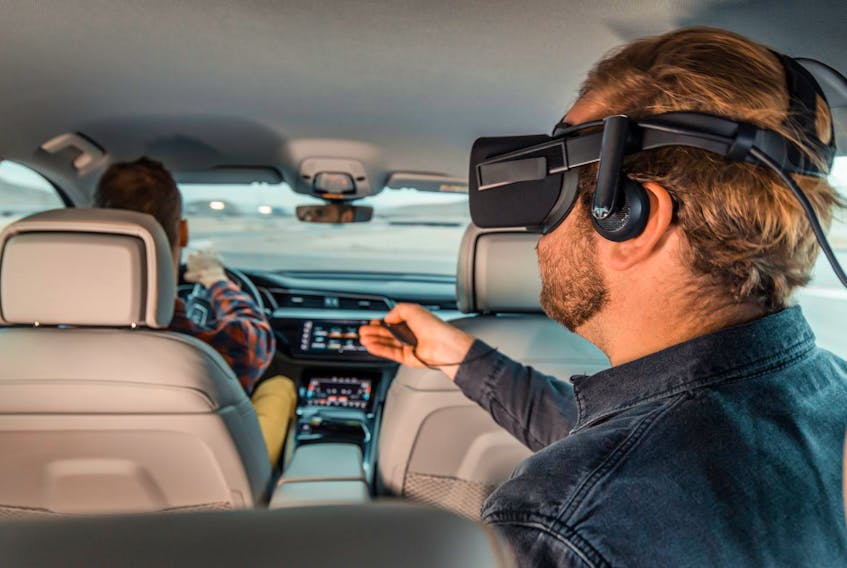LAS VEGAS — Holoride might be the thing that puts an end to the interminable boredom of being in a car. Or, it could be a very quick way to give yourself motion sickness and ruin the upholstery. Developed by Audi in collaboration with Disney, Holoride’s first demonstration at the Consumer Electronics Show in Las Vegas earlier this year had passengers wearing clunky virtual reality goggles to play a video game as they were driven briskly around a racetrack.
You’re putting a lot of trust in your driver. As the Audi SUV accelerates hard to 140 km/h, the players/passengers in the backseat are immersed in the virtual cockpit of a spaceship as it blasts off into a techni-colour asteroid belt. Rocket, the profane raccoon from Guardians of the Galaxy is your co-pilot.
As you move your head you see all around the cockpit. Rocket tells you to shoot at asteroids using a hand-held controller. As the car takes a hard left so does your spaceship.
The motion of the virtual world syncs up to the real world. Iron Man suddenly flies in; he needs your help to blow up something. The car/spaceship dodges left and right; you’re blasting alien ships to smithereens and then you’ve arrived at your destination. How much time passed it’s hard to say.
It’s as close to the sensation of being in a spaceship as most of us will ever get. And it only made me slightly queasy.
“Every street turns into a canvas for creators of virtual worlds,” says Nils Wollny, head of Audi’s digital business unit. It’s a new form of entertainment he calls “elastic content.” “It’s the end of linear entertainment,” he proclaims.
The game adapts in real time to your trip and the motion of the car. The game could be five minutes long, or hours.
We’re interested in all kinds of new platforms. We want to be wherever consumers are.
Mike Goslin, Disney’s vice president of games and interactive experiences
Every day, 50 million trips are made by the major ride-hailing companies such as Uber and Lyft, says Wollny. That works out to 18 billion trips annually, in which there is — quite often — a bored passenger in the back seat. That’s a big untapped market.
The company studied the queasiness problem and found Holoride supposedly reduced the likelihood of motion sickness — although your mileage may vary. Because the motion you see matches up to the motion you feel, it’s less of a shock to the senses than a stationary virtual reality experience, he explained.
Playing Fortnite on your phone in a car would certainly make you turn green faster.
The CES demo, Marvel’s Avengers: Rocket’s Rescue Run, was created by Disney. There are no plans to release it to the public, says Mike Goslin, Disney’s vice president of games and interactive experiences.
“Disney is thinking about the long term here,” he says. “We’re exploring at this point, but we do think there are possibilities. There is a lot of time in vehicles in which we can entertain people.”

Virtual reality experiences won’t be for everyone, he admits. “The car as an entrainment platform, there are other ways to deliver content. We’re interested in all kinds of new platforms. We want to be wherever consumers are.” Increasingly, that means stuck in traffic.
As of Feb. 1, Nils Wollny became CEO of Holoride, which Audi spun off as an independent startup — although the automaker is retaining a minority stake.
Holoride is aiming to have publically-playable games available by late 2020 or early 2021. Wollny envisions a subscription model in which customers could load up the app whenever they’re riding in a car.
Users could play any number of games created by third-party developers. Holoride will share revenue with automakers or ride-hail companies that integrate the technology into their cars; it won’t only be playable in an Audi.
The Holoride demo was cheesy, but undeniably fun. It made me want to play again, to go for a high score. However, there are so many unanswered questions: will people trust ride-hail drivers enough to feel safe wearing a VR headset in traffic; will social stigma prevent people from wearing the headsets?
Competition for people’s attention is fierce, and this opens up a new frontier. The potential audience will only grow as cars become fully autonomous and ride-hailing services become even more ubiquitous.
Weather it is Holoride, Audi, Disney, or some other amalgamation of companies, someone is going to make a lot of money entertaining people who are bored in cars.









